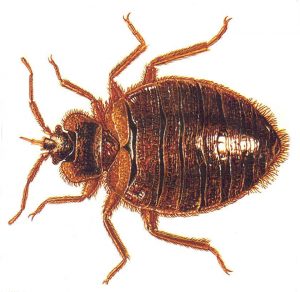

Adults measure 3/16 inch long and are broadly oval and flat. Bed bugs are amber to reddish brown in colour, depending on how recently they fed.
HABITS:
Bed bugs harbor in cracks and crevices during the day and come out to feed at night. Typically they can be found around mattress buttons and beading, in box springs or their coverings, and in any crevice of a wooden bed frame, such as where members join. Other places to check are wall hangings such as picture frames, night stands, stuffed furniture, baseboards, floorboard cracks, behind loose wallpaper, light switches, door and window frames, conduits, etc. In heavy infestations, bed bugs may be found in wall voids, attics and other enclosed places. They will crawl considerable distances to obtain a blood meal.
They can be introduced into a structure via used furniture or in the belongings of someone who has been living in a bed bug infested situation. Adults can survive for up to 6-7 months if they are well fed and they can feed on other animals if humans are not present. When the temperature falls below 61F adults enter semi hibernation and can survive for months.
Bed bug infestations have been found in transportation vehicles such as boats (including cruise ships), trains, airplanes and buses as well as in movie theatres where they typically harborage in seats and associated frames.
Besides the characteristic obnoxiously sweet odor, the other primary clues to an infestation will be the presence of bed bugs and/or small red to reddish brown fecal spots here and there on surfaces.
DIET:
Humans are the preferred host of these insects but in their absence bed bugs will feed on poultry, canaries, English sparrows, mice, rats, rabbits, guinea pigs and bats.
LIFE CYCLE:
Female bed bugs lay from 1 to 12 eggs per day. Female bed bugs lay 1 to 5 eggs per day with the 1/32 inch long, white eggs being deposited individually in cracks or on rough surfaces and secured with a transparent cement for an average total of 200 eggs; maximum eggs per day is 12, with 541 for a lifetime. There are 5 nymphal instars with a blood meal required for each molt. About 3 to 10 minutes are required for each blood meal, during which saliva containing an anticoagulant is injected. Developmental time (egg to adult) takes 21 days at 86F to 120 days at 65F. The threshold for egg hatching, nymphal development and adult activity is 55 to 59F. Below 61F adults enter semi-hibernation and the heat stress death point is 111 to 113F.
Without a blood meal, once-fed nymphs can survive an average of 51 days (range 28 to 73) at 81F and 70 to 75% RH. Being poorly fed can greatly prolong the life cycle (up to several years in some studies). With normal feeding and reproductive cycles, individuals can live up to 316 days. Not all bed bugs in a residence will feed concurrently. They remain concealed until hungry.
BED BUG BITES:
Although the bite of bed bugs is painless, most people (80%) develop an allergic reaction to the saliva injected by the bug as it feeds. A swelling usually results from feeding but there is no red spot such as is characteristic with flea bites. Swelling may be severe and extend beyond the immediate bite area in highly sensitive individuals. Although bed bugs have been suspect in the transmission of many diseases or disease organisms in humans, in most cases conclusive evidence is lacking.
PREVENTION TIPS:
PREVENTION TIPS(WHILE TRAVELLING):
CONTROL METHODS:
Bed bugs have become a difficult pest to eradicate because of their ability to hide and harbour in the tiniest of cracks and crevices because their body is rather flat. To complicate matters worse, the conventional treatments for bed bugs have been a disappointment. The chemicals being used for bed bugs sometimes do not penetrate far enough into the harborages to have any effect or never come into contact with the bed bug. Even when coverage is adequate, some populations have been tested to be resistant to pyrethroids, the active ingredient used to treat most pest control situations. The solution for this problem is heat! Not only does heat kill bed bugs, it also attracts them making it the perfect tool for bed bug control. It is very important to contact a professional if you suspect that you are facing a bed bug infestation. These professionals have specialized equipment to handle the infestation quickly.
HEAT TREATMENT:
Adams pest control is now using a state-of-the-art heat treatment system to control and eradicate bed bugs. It is ideal for pest control in hotels, hospitals, apartments, dorm rooms, military barracks, nursing homes, cruise ships or anywhere else you need to eliminate pests quickly, safely and quietly. Since our heaters are electrically powered, they are extremely quiet, there are no risks of pesticides unpleasant fumes and odours, fire, explosion and water vapour that cause mold that are associated with gas kerosene and propane heaters, making this solution the ideal choice for residential and commercial applications.
Adams Pest Control can help you get rid of bed bugs using the latest methods, we offer 24-hour emergency service. Having problems with bed bugs? Contact our Pest Control Team Today!
or to book your free inspection with an Adams technician today, call 902-220-4003(Nova Scotia) or 506-461-3122(New Brunswick)